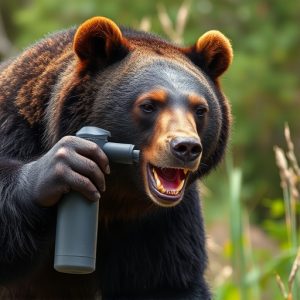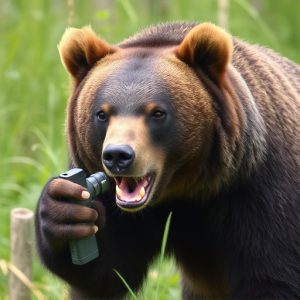Alaska Bear Safety: Gear, Repellents, and Storage Tips
In Alaska's wilderness, understanding bear risks and using proper precautions like storing bear…….
In Alaska's wilderness, understanding bear risks and using proper precautions like storing bear spray within -20°F to 120°F (-40°C to 50°C) is crucial for deterring both black bears and grizzly bears. Choosing effective repellents with active ingredients like capsaicin or pyrethrins, maintaining ideal storage temperatures of 50°F to 70°F (10°C to 21°C), and keeping the spray accessible yet secure enhances safety during hikes on Alaska's diverse terrain.
Alaska’s rugged wilderness attracts adventurers, but it also harbors bears. Understanding bear encounters and preparing with the right gear is crucial for a safe hike. This guide explores risks, offers advice on choosing effective bear repellents, emphasizes proper storage conditions (including the ideal proper temperature for bear spray storage), and outlines essential hiking gear to enhance safety in bear country.
- Understanding Alaska's Bear Encounters: Risks and Precautions
- Choosing the Right Bear Repellent: Active Ingredients and Efficacy
- Proper Storage of Bear Spray: Ensuring Optimal Performance
- Hiking Gear Essentials for Bear Country: Beyond Bear Spray
Understanding Alaska's Bear Encounters: Risks and Precautions
In Alaska, bear encounters while hiking are a serious concern, with both black bears and grizzly bears (or brown bears) present in many areas. Understanding the risks involved and taking appropriate precautions is vital for anyone venturing into these wilderness regions. Bear repellent gear, such as canisters of bear spray, plays a crucial role in minimizing potential dangers during outdoor activities.
When it comes to storing and using bear spray, knowing the proper temperature range for its effectiveness is essential. Bear sprays are designed to deter bears through irritants, but their performance can be affected by extreme temperatures. Typically, these repellents should be stored between -20°F (-29°C) and 120°F (49°C). Beyond these ranges, the spray may lose its potency, which could prove problematic during a bear encounter. Hikers should also ensure their gear is accessible and easily deployable, as quick response times are critical in deterring aggressive bears.
Choosing the Right Bear Repellent: Active Ingredients and Efficacy
Choosing the right bear repellent is paramount for any hiker venturing into Alaska’s wilderness. Look for products containing active ingredients proven effective against bears, such as capsaicin, a compound derived from chili peppers, or active pyrethrins, which disrupt a bear’s sensory perception. Bear spray is a popular choice due to its ease of use and rapid effectiveness, but it’s crucial to select one designed for cold weather conditions, as proper temperature control ensures the spray remains potent during Alaska’s chilly summers.
When considering bear repellent gear, check the recommended storage temperatures on the label. Most bear sprays are designed for temperatures up to -40°F (-40°C), which is relevant when stored in a backpack or car during hikes. Ensuring your repellent stays within this range guarantees its efficacy when you need it most, providing peace of mind as you navigate Alaska’s stunning but potentially dangerous landscapes.
Proper Storage of Bear Spray: Ensuring Optimal Performance
Proper storage of bear spray is essential to ensure optimal performance when you need it most during a hike or outdoor adventure in Alaska’s rugged wilderness. Bear spray should always be stored in its original container, kept out of direct sunlight, and maintained within a proper temperature range. Extreme temperatures can affect the spray’s effectiveness, so avoid storing it in your car’s glove compartment or trunk, especially during hot summer days or cold winter nights. Instead, keep it in a cool, dry place like a closet or outdoor storage shed, where the temperature remains relatively consistent.
The recommended storage temperature for bear spray is between 50°F and 70°F (10°C to 21°C). Temperatures below freezing or above 90°F (32°C) can compromise the integrity of the spray mechanism and reduce its potency. Additionally, ensure that the bear spray is stored upright and away from heat sources, sharp objects, and direct contact with skin or clothing, as these factors could accidentally trigger a release. By adhering to proper storage practices, you’ll maximize the reliability of your bear repellent during your hikes in Alaska’s beautiful but potentially dangerous terrain.
Hiking Gear Essentials for Bear Country: Beyond Bear Spray
When venturing into bear country, it’s essential to go beyond just carrying bear spray – though that remains a crucial component of your hiking gear. A robust and reliable backpack, sturdy footwear designed for rugged terrain, and resilient clothing are fundamental. Opt for layers that can be easily added or removed based on temperature fluctuations, as bears are often most active during dawn and dusk when conditions can change quickly.
Remember, the proper storage of bear spray is equally vital. Keep it in an accessible yet secure location within your backpack, ensuring it’s stored at the recommended Proper Temperature for Bear Spray to maintain its effectiveness. A well-prepared, thoughtful approach to your gear will not only enhance your safety but also contribute to a more enjoyable hiking experience in Alaska’s breathtaking landscapes.
When hiking in Alaska’s bear country, a well-prepared hiker is empowered and protected. By understanding potential encounters, selecting effective repellents with key active ingredients, properly storing them at the right temperature, and packing essential gear, you can navigate these wild landscapes with confidence. Remember, knowledge is your best defense against unexpected bear encounters. Always follow local guidelines and stay safe while exploring Alaska’s stunning wilderness.


